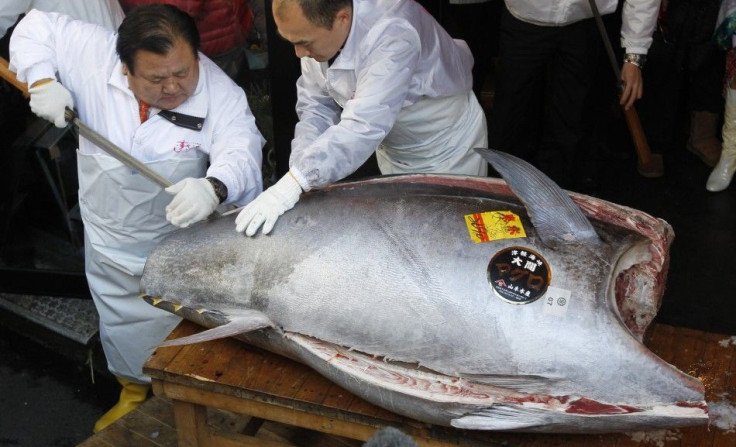Bluefin Tuna Blues: Japan's First Tuna Auction Of Year Is Pure Showmanship, Critics Say

Sometime in the next few days, a Bluefin Tuna is expected to be sold for a lot of money in Japan -- with consequences for the rest of its dwindling family in the Pacific, conservationists say.
The first Tsukiji Market tuna auction of the year generally falls within the first week of January, and restauranteurs are generally willing to pay a huge premium for the first fish -- and reap the press bonanza that follows. Last year, Tokyo-based sushi chain Kiyomura K.K. paid 155.4 million yen ($1.76 million) for the first Bluefin of 2013. The fish weighed about 489 pounds and was caught off the northeastern coast of Japan.
But the Bluefin’s celebrity status has led to the decimation of is population. The most recent stock assessment from the International Scientific Committee for Tuna and Tuna-like Species in the North Pacific Ocean, or ISC, shows that the Pacific Bluefin population stands at about 4 percent of its unfished size.
“Not only was there this 96 percent decline, but [the ISC also found that] declines have been steady for about 15 years,” says Amanda Nickson, the director of the global tuna conservation unit at The Pew Charitable Trusts. “They also found that the catch is primarily composed of juveniles. They’re being fished before they can contribute to the population.”
Fishermen and scientists alike say the Tsukiji auction is a performance that distorts the actual picture of the Bluefin Tuna market worldwide. While that first Bluefin of 2013 sold for about $3,600 a pound, the average price that U.S. fishermen received for Bluefin Tuna in 2011 was only a little more than $10 a pound, according to a report from the National Marine Fisheries Service [PDF].
“The notion that the price paid for this particular fish has any affect at all on the price of Bluefin harvested in the U.S. or anywhere else in the world is ludicrous,” New York-based fisherman David Schalit said in a comment on a New York Times blog post in 2013. “US scallop fishermen are regularly paid more for their catch.”
Duke University-trained marine biologist Andrew David Thaler called the auction a “performance” designed to drive up demand for Bluefin in a post on the blog Southern Fried Science.
“By making Bluefin Tuna seem desirable through an artificially inflated value — a value that is then repeated around the world as the going-price of tuna — we not only increase consumer demand for those tuna but increase the pressure on fish stocks, as fishers willing to chase a million-dollar fish will be less deterred by regulation and more willing to accept the toothless penalties for violating quotas as simply the cost of doing business,” Thaler wrote.
Nickson and colleagues at Pew have called on the Western and Central Pacific Fisheries Commission, or WCPFC, to initiate a long-term Bluefin rebuilding plan this year. Ideally, the plan would include catch limits that would restore the Pacific Bluefin population to 25 percent of its original size by 2024, and minimum size limits on catch.
But in the short-term, the outlook looks grim: in September, the WCPFC set juvenile catch limits at a level that will actually increase the amount that countries can catch over last year, according to Nickson.
“In our view, very strong management actions need to be put in place,” Nickson says. “If there’s not an end to Pacific Bluefin fishing, what’s needed is to have a scientifically-informed catch limit.”
© Copyright IBTimes 2024. All rights reserved.





















